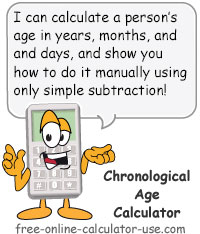IMPORTANT: Numeric entry fields must not contain dollar signs, percent signs, commas, spaces, etc. (only digits 0-9 and decimal points are allowed).
Click the Terms tab above for a more detailed description of each entry.
Step #1:
Select the month, day, and year of the test date.
Step #2:
Select the month, day, and year of the date of birth.
Step #3:
Click the "Calculate Chronological Age" button. This will display the age in years, months, and days, plus display the step by step process used by the calculator to find the solution.


Follow me on any of the social media sites below and be among the first to get a sneak peek at the newest and coolest calculators that are being added or updated each month.